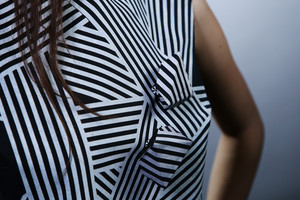
Scientists from the MIT Media Lab believe that future jewelry should not be static, but “living objects on the body.” So they developed Kino, a line of jewelry that can move and interact with the environment.

These futuristic accessories are essentially miniaturized robots that are held in position by magnets. They can move in any direction as they have their own custom circuit boards and on-board batteries. With a few simple add-ons, like temperature sensors or a bluetooth microphone and speaker, these robots can perform a variety of practical tasks, like pull off your hood when they sense an increase in temperature, as you can see in the video above. Scientists’ goal in the future is to make the robots smaller so that they’ll fit in existing ornaments.
--- https://www.media.mit.edu/projects/kino-kinetic-wearable/overview/ --Here the Scientists explain the project--: This work explores a dynamic future in which the accessories we wear are no longer static, but are instead mobile, living objects on the body. Engineered with the functionality of miniaturized robotics, this "living" jewelry roams on unmodified clothing, changing location and reconfiguring appearance according to social context and enabling multiple presentations of self. With the addition of sensor devices, they can actively respond to environmental conditions. They can also be paired with existing mobile devices to become personalized on-body assistants to help complete tasks. Attached to garments, they generate shape-changing clothing and kinetic pattern designs—creating a new, dynamic fashion.
It is our vision that in the future, these robots will be miniaturized to the extent that they can be seamlessly integrated into existing practices of body ornamentation. With the addition of kinetic capabilities, traditionally static jewelry and accessories will start displaying life-like qualities, learning, shifting, and reconfiguring to the needs and preferences of the wearer, also assisting in fluid presentation of self. With wearables that possess hybrid qualities of the living and the crafted, we explore a new on-body ecology for human-wearable symbiosis.
Example Applications
Pattern Changing: Cover designs camouflaged with the underlying textile can morph between unique patterns effects. We present an example of a stripe pattern with matching device covers. By shifting its location on the body, the device creates different aesthetic effects.
Shape-changing jewelry: Multiple devices can become building blocks to form jewelry design. With its mobility, the individual pieces can form various shapes and designs. We present an application of a jewelry set that transistions between a minimalistic brooch for going to work, and a necklace statement piece for going out.
Climate Reactive Clothing: The robots can trigger clothing to actively adapt based on the climate or comfort needs of the wearer. We created a coat and connected each drawstring of the hood to a device. Upon detecting an increase in temperature, the devices move downwards to unfold the hood.
Etching patterns: When moving, the devices can etch into specific fabrics and "draw" patterns. On fabrics such as velvet, the robots leave visible tracks during movement - the clothing becomes a canvas to etch designs. The traces are temporary and therefore new patterns can be generated.
Quelle: MIT Media Lab Resaerch
